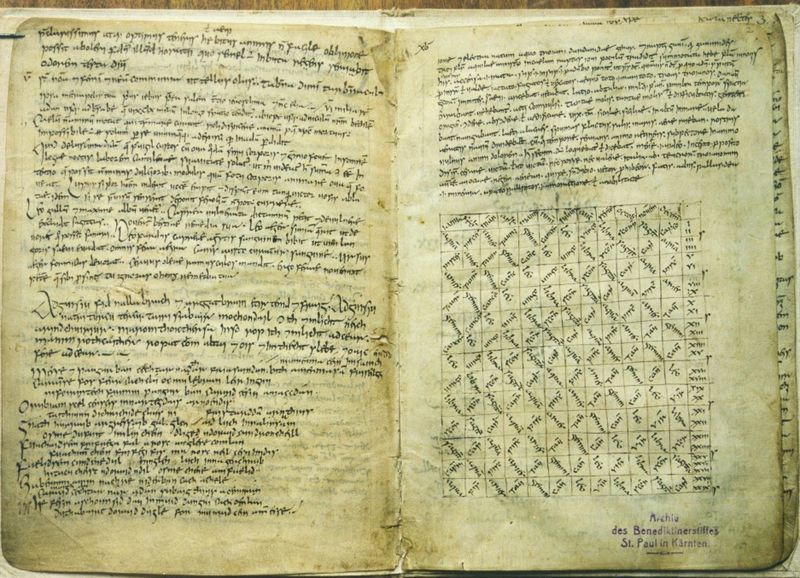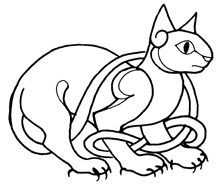Pangur Bán is probably the most famous surviving poem from Early Ireland[i]. Composed by an Irish monk sometime around the 9th century AD, the text compares the scholar’s work with the activities of a pet cat, Pangur Bán. It is now preserved in the Reichnenau Primer at St. Paul’s Abbey in the Lavanttal, Austria. The version detailed below is Robin Flower‘s translation of the poem from Old Irish.
I and Pangur Bán my cat,
‘Tis a like task we are at:
Hunting mice is his delight,
Hunting words I sit all night.
Better far than praise of men
‘Tis to sit with book and pen;
Pangur bears me no ill-will,
He too plies his simple skill.
‘Tis a merry task to see
At our tasks how glad are we,
When at home we sit and find
Entertainment to our mind.
Oftentimes a mouse will stray
In the hero Pangur’s way;
Oftentimes my keen thought set
Takes a meaning in its net.
‘Gainst the wall he sets his eye
Full and fierce and sharp and sly;
‘Gainst the wall of knowledge I
All my little wisdom try.
When a mouse darts from its den,
O how glad is Pangur then!
O what gladness do I prove
When I solve the doubts I love!
So in peace our task we ply,
Pangur Bán, my cat, and I;
In our arts we find our bliss,
I have mine and he has his.
Practice every day has made
Pangur perfect in his trade;
I get wisdom day and night
Turning darkness into light.

[i] The poem is written in Old Irish and was probably composed by an Irish monk who was studying at a continental European monastery.




How is it that a poem that was originally written in old Irish just happens to rhyme perfectly in every couplet when translated to modern English? Seems very unlikely, so some “poetic licence” must have been used. Is there a direct (more accurate) translation available anywhere?
Hi Magella, here is the original text, it’s beyond my capabilities to translate it so I couldn’t tell you what the most accurate version is
Messe [ocus] Pangur bán,
cechtar nathar fria saindán;
bíth a menma-sam fri seilgg,
mu menma céin im saincheirdd
Caraim-se fós, ferr cach clú,
oc mu lebrán léir ingnu;
ní foirmtech frimm Pangur bán,
caraid cesin a maccdán.
Ó ru-biam scél cén scis
innar tegdias ar n-oéndis,
táithiunn dichríchide clius
ní fris ‘tarddam ar n-áthius.
Gnáth-huaraib ar greassaib gal
glenaid luch ina lín-sam;
os me, du-fuit im lín chéin
dliged ndoraid cu n-dronchéill.
Fúachaid-sem fri freaga fál
a rosc a nglése comlán;
fúachimm chéin fri fégi fis
mu rosc réil, cesu imdis.
Fáelid-sem cu n-déne dul,
hi nglen luch ina gérchrub;
hi-tucu cheist n-doraid n-dil,
os mé chene am fáelid.
Cia beimini amin nach ré
ní derban cách a chéle;
mait le cechtar nár a dán
subaigthiud a óenurán.
Hé fesin as choimsid dáu
in muid du-n-gní cach óenláu;
do thabairt doraid du glé
for mumud céin am messe.
Here is a more literal translation:
I and white Pangur,
each of us two (keeps) at his specialty:
his mind is set on hunting,
my mind on my special subject.
I love (it is better than all fame)
to be quiet beside my book, with persistent inquiry.
Not envious of my White Pangur;
_he_ loves his childish art.
When we two are (tale without boredom)
alone in our house,
we have something to which we may apply our skill,
an endless sport.
It is customary at times for a mouse to stick in his net,
as a result of warlike struggles (feats of valor).
For my part, into _my_ net falls
some difficult crux of hard meaning.
He directs his bright perfect eye
against an enclosing wall.
Though my (once) clear eye is very weak
I direct it against acuteness of knowledge.
He is joyful with swift movement
when a mouse sticks in his sharp claw.
I too am joyful
when I understand a dearly loved difficult question.
Though we are always like this,
neither of us bothers the other:
each of us likes his craft,
rejoicing alone each in his.
He it is who is master for himself
of the work which he does every day.
I can perform my own task,
directed toward understanding clearly that which is difficult.
Thank you Breandán – this is vey enlightening! It is inspiring for people who work diligently on their specialisation and the quiet joy and satisfaction that comes with persistance and dedication.
It is an incredble piece of literature that appears so simple, yet conveys the humanity and intelligence of the person who wrote it and as I understand, that each has his own purpose, neither one is better than the other. It is so amusing to think that the poet compared his work and his art with his pet cat! I love where he says “neither if us bothers the other.” It’s just wonderful.
Breandán, I’d like to copy this translation. Did you do this translation?
Hi Sharon, this is a Gerard Murphy’s version of the poem.
Go raibh míle maith agaibh, a Cholm! One of my favourite poems in Old Irish, it was prominent in the curriculum of my Celtic Studies program at Saint Xavier University last year in Celtic Christianity and especially a course of directed studies in Old Irish I took with my professor. Her own PhD studies involved the translation of Old Irish manuscripts at Trinity College Dublin.
There’s always one, eh?
Flower translated ‘creatively’ there are many schools of literary translation.The literal school is just one
Hi Magella,
What is translation but taking licences over and over again? Accuracy does not come from from being more direct.
There is a difference between translation and transliteration. This is a translation. Translation is a very difficult art, especially when attempting to preserve a rhyme. My hat is off to the translator, who surely preserved the liveliness and charm of the rhyme along with the meaning. If you want more “accurate” or direct versions of things, search “[poem] transliteration”.
So is Pangur Ban a name or does it mean cat in old Irish? Thanks.
Hi Christie, Bán means white in Irish, while Pangur is the pet’s name. The Irish for cat is actually cat. Hope this helps, Colm
Thanks! 🙂
Colm,
Wondering what a silver gray and white striped cat might be called in Irish…I want a special name for my cute new kitty.
pangur ban means white fuller, fuller as in feltmaker.probably referring to how cats knead soft things which looks similar to how people used to knead wool or animal hair to make felt.
No, it refers to the color, as in new wool when it’s washed/beaten clean. IE, the cat is bright white.
Fuller also refers to the groove down the middle of a blade that lightens
the weight of a sword.
He refers to the cat as a hero and a hunter so I think this is a more likely allusion.
White blade sounds more likely a name for such a determined and predatory cat than ”preparer of white cloth”.
The poem is such a tribute to the joys of quiet companionship that
1200 years melt away and the kindly monk and his white cat reach across the centuries to our more superficial and noisesome world. Thanks for publishing this.
Thank you, Colm. I have long loved the English poem and even have a copy purchased at Trinity. Always wondered about his name.
Is the accompanying illustration ancient Irish or simply celtic-looking?
Sorry Ken, I missed your comment. It’s a modern image loosely based on the cat from the Book of Kells.
Was the design made of words on he lower half of the right page part of the poem? Or is it another poem? Or is it mainly a decoration?
If you want to learn more about Pangur Bán then you could read Celia Keenan, ‘The hunt for Pangur Bán’ in Nora Maguire & Beth Rodgers (eds) Children’s Literature on the Move: Nations, Translations, Migrations (Four Courts, 2013).
Thanks Martin
Hello Colm – Love the translation and description. How would you pronounce Pangur Ban? I’m always hung up on how Irish words should sound in my head as I read them. I’m not very good with it.
Thanks, Gae Mitchell
Hi Gae, Pangur=as in frying-Pan, gur (as in rhymes with fur), while Ban sounds like Bawn (as in rhymes with pawn). Hope this helps, Colm
While we never spoke Irish at home, we did have a grey cat with four white paws. Somehow she got named Brogha Bana.
Which was our rough translation for “White boots”.
Nigel in Cavan.
Check out PoetryBeo App in the apple app store. It has poems recited in Irish and explained in both Irish and English. The video recitations are performed by people with the same gender and dialect as the poets. It really brings the poems alive. It features another fine poem in Irish about a cat. Colscaradh by Pádraig Mac Suibhne .
Pangur Ban also features prominently in The secret of Kells, but of course you all knew that already!
To anyone interested: there are multiple translated versions of the poem. The one from this post is by Robin Flower. There are also versions by Gerard Murphy, Seamus Heaney, W.H. Auden, and J. Marchand. You can easily find these versions on google!
I purchases in Ireland a tee shirt years ago that had the 1st verse of the poem and the cat drawing posted above. It was a gift for my husband who is a writer. The shirt was his favorite but it finally wore out after many, many years. I would love to surprise him with a new one but have scoured the internet to no avail. Does anyone know where I might find another? I know this post is not in keeping with the tenor of the others but it’s my last hope! Thanks.